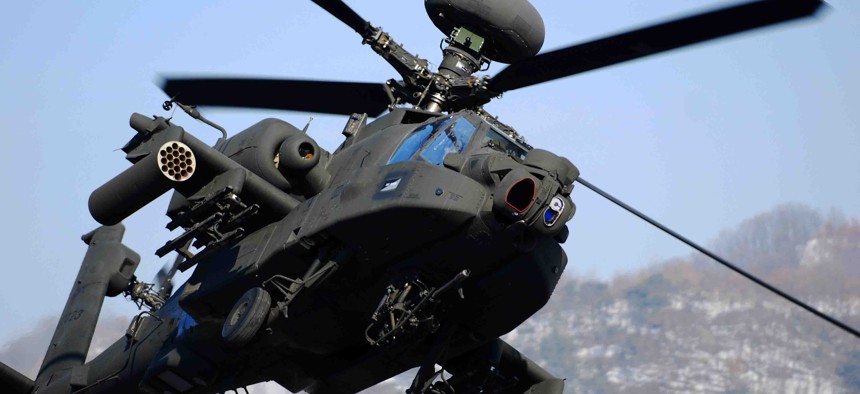
Lawmakers added one-quarter of the extra Apache attack helicopter requested by the Trump administration. U.S. Army
Defense Firms Score in 2017 Budget Deal
Arms procurement goes from a requested cut under Obama to a plus-up under Trump.
Mark down an early, if modest win for the military services and defense firms. Fourteen months ago, the Obama administration’s 2017 budget request proposed to cut funding for buying new weapons by nearly 6 percent. Instead, Congress this week agreed a $593 billion defense-spending deal that will boost arms spending by 4 percent.
While Congress did not rubber-stamp all of the $15 billion for arms sought by the Trump administration in its own 2017 request in March, it did greenlight many of the items requested, including drones, helicopters, bombs, and missiles. All are in high demand in the war against Islamic State militants in Iraq and Syria.
Lawmakers also added billions of dollars for F-35s, ships, and helicopters that did not appear in either Trump’s March request or Obama’s original request.
The money, which Congress is expected to approve by week’s end, will bring total Pentagon weapons spending in fiscal 2017 to $123.3 billion. That’s $4.7 billion more than in 2016, according to Roman Schweizer, an analyst at Cowen and Company. (The Obama administration had requested $112.1 billion.)
Lawmakers also approved $73.7 billion for research-and-development projects, up $3.7 billion, or 5.3 percent, from last year. (Obama had requested $71.8 billion.)
Still, the Trump didn’t get all of the additional weapons it asked for. Congress approved 14 F/A-18 Super Hornet combat aircraft, of 24 requested. Instead of the requested 20 additional Apache attack helicopters, lawmakers approved five. And the Navy got none of its extra six P-8 submarine-hunting planes. All three aircraft are made by Boeing.
As Northrop Grumman CEO Wes Bush said on an earning call last week: “Absent some dramatic event, we should expect a modest upward trend for the foreseeable future in national security spending.”
Congress’ budget deal this week is exactly that.





